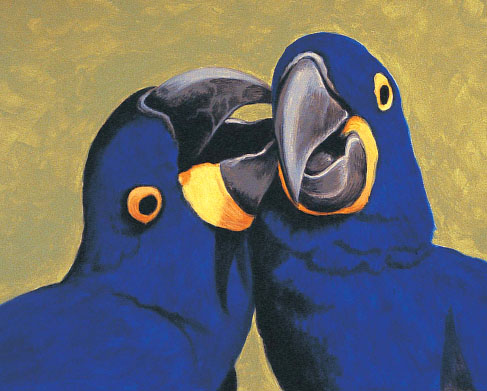Project 50: Hyacinth Macaws
I observed these hyacinth macaws at the Caldwell Zoo in Tyler, Texas. They were a very loving pair—constantly grooming and nibbling at each other and locking beaks in what looked very much like a kiss.


Reference Photo
Materials
Paints
Burnt Sienna
Burnt Umber
Cadmium Orange
Hansa Yellow Light
Naples Yellow
Raw Sienna
Titanium White
Ultramarine Blue
Brushes
no. 3 and 10 rounds
no. 10 bright

1 Establish the Form
Lightly draw the macaws onto the panel in pencil, using a kneaded eraser to make corrections or lighten lines. With a no. 10 round and diluted Burnt Umber, paint the basic lines and shading.

2 Paint the Dark Value Colors
Create blue-black with Burnt Umber and Ultramarine Blue. Paint the darkest areas with a no. 10 round.

3 Paint the Middle Values
Make a blue feather color with Ultramarine Blue and small amounts of Titanium White and Burnt Umber. Paint with a no. 10 bright following the contours of the birds. Use a no. 10 round for painting smaller areas. When dry, add another coat.
Create yellow-orange for the shaded areas of the parrots’ yellow markings with Hansa Yellow Light, Cadmium Orange and Raw Sienna. Paint with a no. 10 round.
Make warm gray for the beaks and tongue with Titanium White, Burnt Umber, Ultramarine Blue and Burnt Sienna. Paint with smooth strokes using a no. 10 round.

4 Paint the Light Values and Background and Begin to Add Detail
Mix a soft green for the background with Naples Yellow, Ultramarine Blue and Titanium White. Paint with dabbing strokes using a no. 10 bright; use a no. 10 round for around the parrots’ outlines.
Mix light gray for beak highlights with a portion of warm gray, Titanium White and a bit of Raw Sienna. Paint with a no. 10 round.
Mix a yellow highlight color for the parrots’ markings with a portion of yellow-orange, Titanium White and a small amount of Hansa Yellow Light. Paint with a no. 10 round, blending with a separate brush and yellow-orange.
Begin to add detail to the beaks and feathers with blue-black and a no. 10 round. Paint parallel, light-pressured strokes.
Tip
To achieve a semi-dry brush, wipe the brush lightly on a paper towel after dipping it into the paint.

AFFECTIONATE PAIR
Acrylic on Gessobord
8” × 10” (20cm × 25cm)
5 Add the Finishing Details
Mix some of the blue feather color and Titanium White to create a pale blue for the feather highlights. With a no. 10 round, paint lightly with semidry, parallel strokes that follow the feather pattern. If your paint is too soupy, transfer a portion to a dry palette. Tone down as needed with the blue feather color.
Continue to add dark detail to the feathers and beaks with blue-black and a no. 10 round. Indicate the tongue of the parrot on the left with warm gray.
Mix a rusty orange for detail in the yellow areas around the beaks and eyes with a portion of yellow-orange mixed with Burnt Sienna and Cadmium Orange. Paint thin lines with a no. 3 round, blending with a separate no. 3 round and the adjacent color.
Refine the shape of the eyeballs with a no. 3 round and blue-black. With a no. 3 round, paint the lower eyelids with a bit of warm gray mixed with a bit of light gray.
Paint highlights in the eyes with pale blue. Add a little more detail in the shoulder area of the bird on the left with quick, light strokes of pale blue and blue-black.
Mix a beak highlight color with Titanium White and a touch of Hansa Yellow Light. Paint with a no. 3 round, blending the edges with the adjacent colors: warm gray and light gray. Also, add more detail to the beaks with those colors and a no. 3 round.
